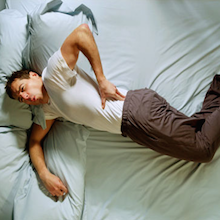Whether you’re an outdoor cyclist or prefer a spin bike, there are some easy ways you can optimize your output and performance. Learning more about your form will also translate into injury prevention and overall comfort on your bike.
We hear a lot about cross-training which refers to other forms of exercise to maintain your cardiovascular fitness, while it is important to switch it up, complimentary training is also important. Complimentary training is to improve your specific sport, for cyclists, this could be a pedaling technique or bike handling skills.
For cycling form, you need enough mobility and stability to be efficient symmetrical.
Mobility: we need to have enough motion to be able to circle the cranks. This motion needs to come from hip flexors, hamstrings, and gastroc/soleus (calf). Limitations in flexibility in one of these muscle groups will likely cause compensations.
Stability: core control for energy transfer from legs to trunk and arms. We notably need abdominal and scapular stability to be able to control output.
Posture: proper hip/spine bike posture is critical to avoid injury and maximize performance.
We need to be able to generate power to stabilize against our power output. It is important to maintain a solid foundation at hips, pelvis, core, and shoulders while output goes up. You can’t shoot a cannon out of a canoe, it is important to be able to control the load.
The typical (poor) cyclist pattern is:
– Quad dominance
– Weaker hamstrings
– Decreased glute activation
– Decreased core stability
– Decreased scapular stability
– Poor neck posture
Here are some exercises to check your form and focus on improving stability:
-Broomstick squats: These are great to practice your hip hinge. These are honestly great for anyone, not just cyclists. But these are important to make sure you’re in a good posture and rotating your hips rather than flexing your spine. Be sure not to be flexed and rounded on your bike. Better hip hinge equals better hip activation will translate into increased power no matter what pedal stroke you utilize (squares v circles).
Grab a broomstick, swifter, curtain rod or PVC pipe and place it in contact with your head and with your pelvis, keep the contact and practice squatting. While keeping contact with your head and pelvis, you get an improved hip hinge rather than flexing through your spine. Perform 10x slowly in a mirror to see your form.
-Broomstick hinge on bike: take these onto your bike once you get the hang of the squat. Practice getting a good hip hinge and powering more through your glutes and posterior chain. Also be sure your neck is neutral, elbows are slightly bent and your chest is open.
-Core Pedaling drills: (these are harder on a non-stationary bike) Try maintaining your posture and placing one hand behind your back. Resist the urge to rotate or shift to help improve core control/stability. This is a good drill to build core awareness on your bike. To take this a step further, do the opposite arm/opposite leg by unclipping one leg and try to keep pedaling and maintain your posture. Try this for 45 seconds and switch.
-Bird dogs: this is a good one to practice off of your bike for core control and stability while your arms and legs are moving. Maintain a neutral spine and extend one arm and opposite leg without arching your back. Hold for 5 seconds and repeat 10x on each leg.
-Bridge with leg raise: these are helpful to maintain a neutral pelvis while you’re changing your base of support. Maintain a level pelvis while straightening one leg a time, perform 10x on each leg slowly and controlled. This is important for cycling to be able to maintain your foundation.
-Dead bugs: very similar to bird dogs but in the opposite position. These are really helpful to practice maintaining your back flat on the floor and core controlled while your arms and legs are moving. Keep your back flat and belly button drawn into your spine and lower one leg and opposite arm towards the ground (the closer you go to the floor the harder it will be). Hold for 5 seconds, 10x each side.
Overall, having proper posture and core/shoulder stability is important to be able to maintain form as your output increases to be able to avoid injury. Give these a try and see how you do.
Danielle Taylor PT, DPT



